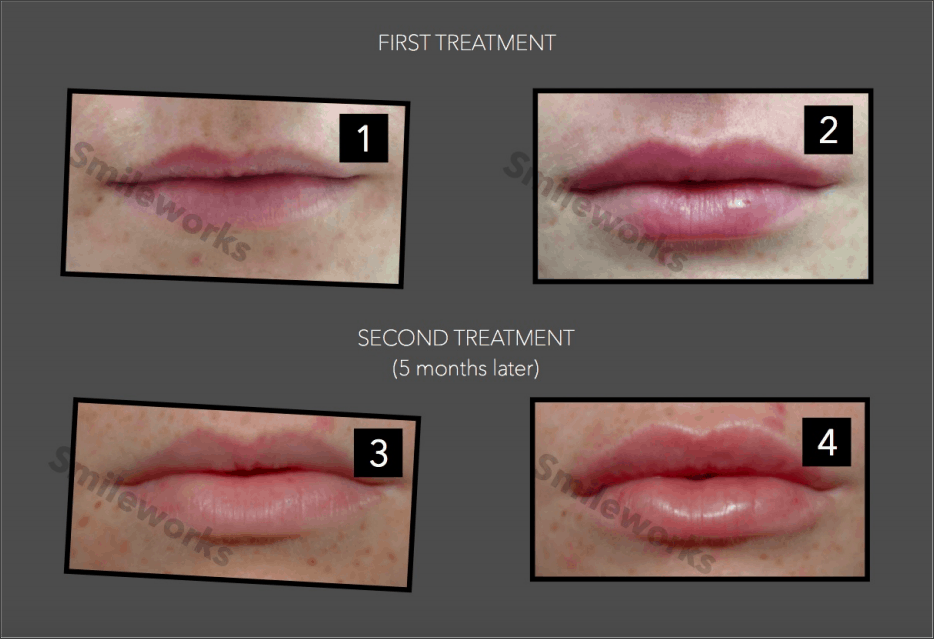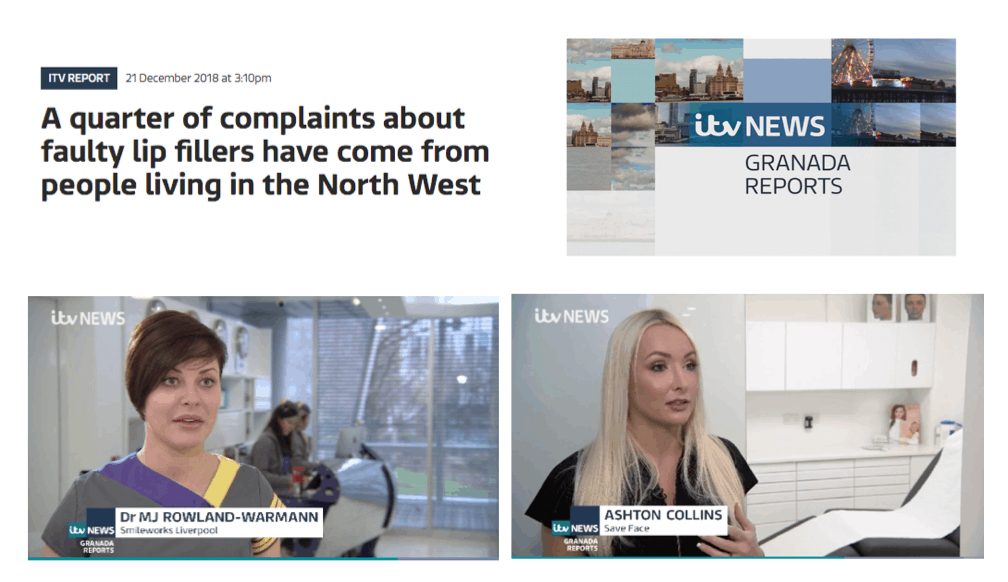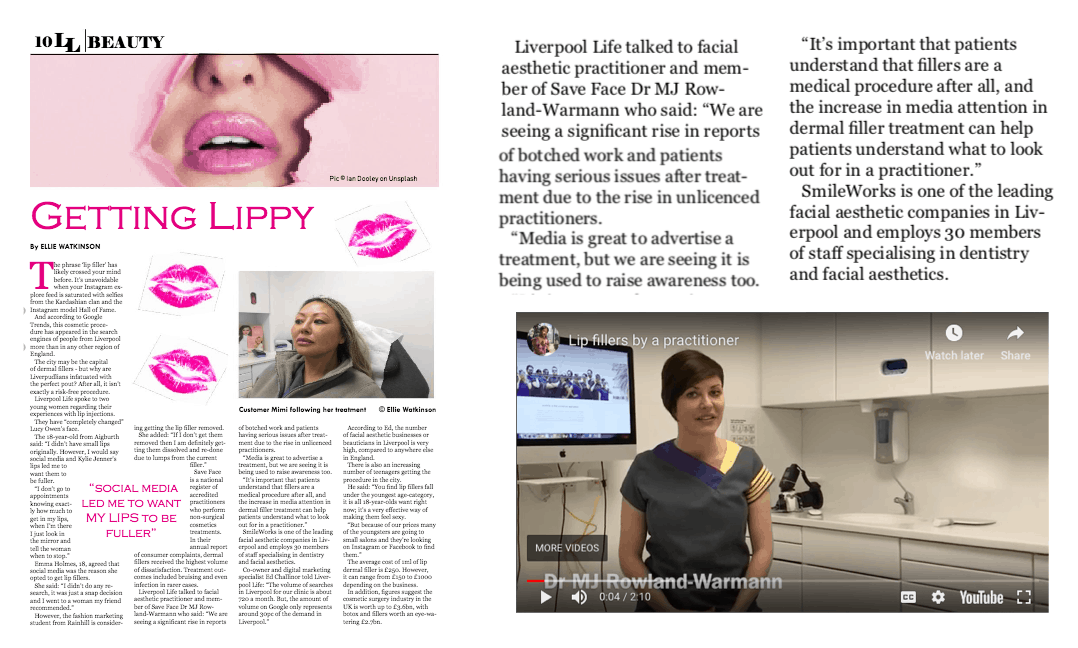Have your fillers gone wrong? Here, Dr MJ Rowland-Warmann BSc BDS MSc Aes.Med. PGDip Endod. MJDF RCS (Eng) gives comprehensive help and advice on a broad range of filler treatments including emergency complications and how you should act when things don’t work out. She talks about the benefits and risks of dissolving filler with Hyaluronidase, what you can expect from this treatment and under what circumstances to have the treatment done.
Here at Smileworks we see dozens of filler complications each week and we are the only dedicated complications clinic in the UK. We accept referrals from other medical practitioners and also self referrals where worried patients call the practice. We use advanced ultrasound to locate and treat complications so that you can get a good resolution to your problem.
Here at Smileworks around 95% of vascular occlusions (a serious kind of complication) resolve if treated within 2 days. Other complications of HA filler will see a 98% successful resolution rate. So get in touch!
If you need to make an appointment or want to speak to an expert right away then call 0151 236 5166 or fill out the form below. Dr MJ is clinical director at the Smileworks Aesthetic Hub, specialising in aesthetic training for dentists. Click the booking link below to make an appointment at our complications clinic.
Here we cover every possible complication and poor outcome so you can feel reassured or seek further help if you’re unhappy with your lips fillers, dermal fillers, tear troughs or other aesthetic procedures.
Dr MJ is registered with the GDC has appeared extensively in the media talking about aesthetic medicienj complications on the BBC and ITV news. Learn more about media appearances here.

Setting expectations of filler treatment
Sometimes expectations of treatment are not met. This doesn’t mean that treatment has gone wrong; it simply means what was achieved and what you had in mind were not the same. It is important to set expectations with your practitioner to make sure the results are realistic and achievable. Fail to do this and you’ll be very likely to end up with a less than satisfactory result.
Sometimes, the desired outcome can only be achieved with repeat treatments, such as in the case of a significant asymmetry of the face or otherwise just to get a really great result (like the one here). For more information on correctly performed lip filler treatments follow the link.
Sometimes, a less than ideal result has to be accepted because patients are all different and circumstances are never the same. So we deal in probabilities not certainties. Although it would be pretty much certain that if you gave an untrained practitioner a syringe of mystery-sourced counterfeit filler and let them loose on you for the first time, they would create a bad result.
Just like if you let your ten year-old behind the wheel of your car you probably wouldn’t get to work in one piece. Practitioners should always try to achieve the very best results, but there has to be a discussion about what is realistic, achievable and safe.
Many of you come to the practice with pictures of pouts you’ve seen on Instagram or on TV. It’s important to consider that whilst lips can be shaped so they appear fuller, more symmetric or more shapely, the Instagram picture may be of a pout that is vastly different to your own.

I always say to my patients,
“We can improve what you currently have to make a better version of you – but I cannot turn you into someone else.” Dr MJ Rowland-Warmann BSc BDS MSc Aes.Med. PGDip Endod. MJDF RCS (Eng)
But there’s a big difference between being born with wonky lips that you don’t like and your practitioner producing a wonky result because of poor technique and inadequate experience. Or worse creating a serious complication, infection or vascular complication.
Lip fillers gone wrong
Many patients come to us from other practices or mobile providers describing ‘wonky lips’, ‘trout pout’, unevenness, ‘duck lips’ or other ghastly lumps, bumps and nasties following treatment:
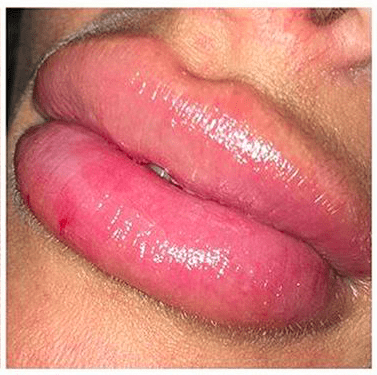
These are called poor aesthetic outcomes, so here’s how to fix bad lips:
- Leave the product to naturally dissolve over time.
- Get them dissolved with Hyalase.
- Choose a better practitioner next time (using our advice below)
Unfortunately, as dermal fillers become more advanced, the manufacturers have given them better staying power. This means patients can be stuck with their bad results for quite a long time before filler dissolves. Depending on the product we’re talking months or even years!
Massage can encourage the filler to be broken up by the body more quickly. But in practice this still takes a long time (like weeks of daily vigorous massage) to improve the outcome. This may also spread the product over a larger area causing more problems.
Note: Massage should NOT be included in your AFTERCARE INSTRUCTIONS. We don’t know where this rumour came from but it’s completely the wrong advice. It doesn’t help it settle or help you heal and may spread it around into areas it was not intended to be. If your aesthetician tells you to massage your lips then you know for sure you’re being treated by an amateur and are probably only going to make things worse.
Dissolve filler with Hyalase (Hyaluronidase)
Hyalase is an enzyme that dissolves HA fillers. It can be used to correct poor aesthetic outcomes, lumpy results and is also the first line treatment in a vascular complication due to filler emergency (see Vascular complications below). You may have heard people say they’ve had their lips dissolved or had the fillers taken out. They will be referring to Hyalase treatment.
Hyalase is a great product which can remedy many a poor outcome, but it must be prescribed by a qualified medical professional with a prescribers’ license. Hyaluronidase is a prescription only product.
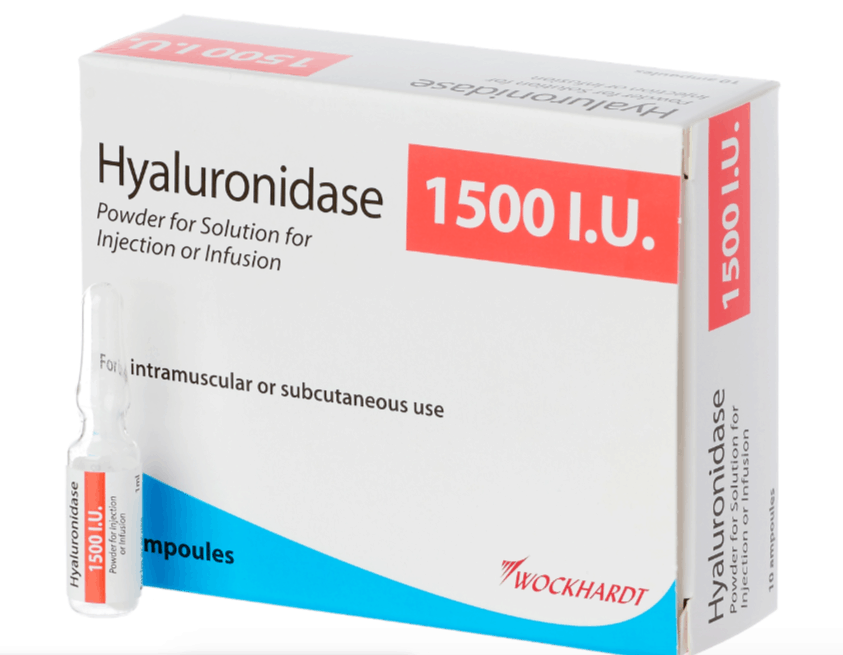
Hyalase is a prescription only product should not be used by:
- Beauticians
- Hairdressers
- Non medical professionals
Hyalase should be used in cases where:
- There is a suspected vascular complication
- Too much filler has been used and is damaging tissue or compressing vessels
- Too much filler is causing an unaesthetic result
- Filler is causing oedema, infection or nodules
Hyalase Cost
The cost of Hyalase treatment can be found by visiting our complications clinic booking page. Depending on whether ultrasound treatment is required, the cost may vary. The treatment will cost between £180-£450
There are risks associated with Hyalase. It’s bovine origin (made from bull’s testicles) means it contains animal protein which people can be allergic to in rare circumstances. Hyalase should only be handled by appropriately trained medics, dentists and aesthetic nurses. If a beautician is planning to ‘take filler out with Hyalase’ they are using it without a license and may be using a counterfeit product. I see this frequently. Recently patients require ultrasound treatment and no beautician has an ultrasound device.
Sometimes when filler goes wrong there are more serious consequences. Patients can get infections, severe bruising and suffer blocked veins and arteries resulting in the tissue literally dying and rotting on your face.
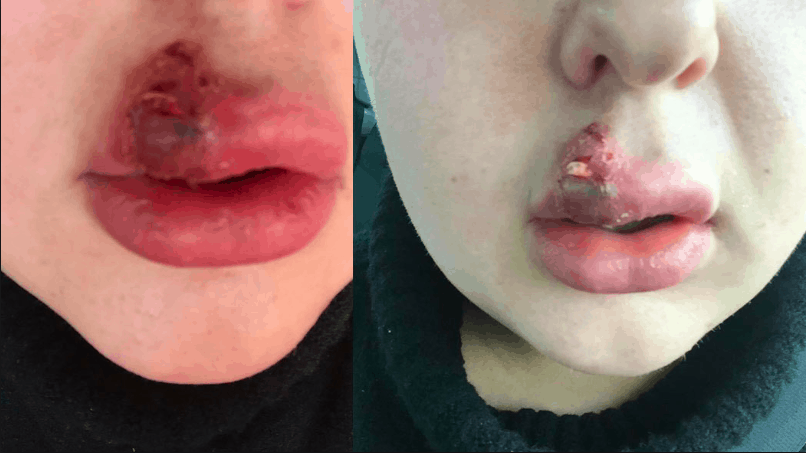
These types of filler emergencies can often be avoided and you must be able to separate the common side effects of filler from medical complications requiring emergency assistance.
Common side effects of Dermal filler
- Common side-effects include bruising, bleeding and swelling, which will usually get better on their own.
- Infections from dermal filler are thankfully rare but can be very serious so need to be treated immediately.
- Nodules, lumps and bumps can occur, either immediately after filler or after some time has passed.
- Allergy to fillers are extremely uncommon.
- Vascular complications and blindness can occur and must be treated as a medical emergency (see vascular complications above)
- Uneven results and poor aesthetic results are common and may require treatment (see above)
- Pain at the treatment site can occur post-operatively but increasing pain may be a sign of infection and should be investigated.
Pain during treatment is common, especially with lip filler. At Smileworks we use dental blocks to reduce pain and increase patient comfort. We have a general rule that pain is a sign that something is wrong. Beauty is not pain – and anything more than a 2 out of 10 should be taken as a warning sign.
Different types of filler complications
Vascular complications
Possibly the most serious complication involves blocking or compressing blood vessels. That means that filler is injected and it causes a blood vessel to become blocked or squashed, which leads to the tissue being deprived of blood. If this is not identified and treated immediately the tissue may die (necrosis) or you might be left with a nasty scar.
If a clinician is suitably qualified, over 90% of vascular complications can be fixed there and then without any long term effects. However, if they go unnoticed you can be left with disfiguring scarring, pain and long term problems.
Can filler cause blindness?
Filler can cause blindness with dozens of cases being reported worldwide and also here in the UK. Blindness is the most serious risk of dermal filler placement and can happen when filler is placed into the mid-facial area, nose, under the eyes and glabella (between the eyes). When injected into certain parts of the circulation, the filler blocks arteries and veins which supply the eye with blood. The result is a permanent ptosis (droopy eye) and loss of sight. This is irreversible and the patient will be left dealing with this for the rest of their life.
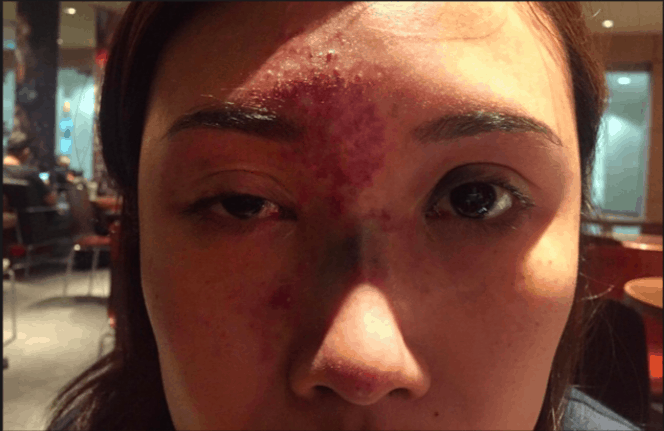
Blindness can be caused by the injection of filler into:
- The nasolabial folds
- Tear troughs
- The glabella
- The mid-facial area
- Cheeks
- Nose
Nose treatments
Nose fillers and tear troughs carry the highest risk of blindness. That said, if an adequately trained and prepared clinician can treat the vascular complication quickly and effectively, these side effects could be avoided.
If you are a clinician looking for protocols for the treatment of vascular complications, follow the link to Dr Rowland-Warmann’s academic article on Vascular Complications from filler here.
It is important you go to a practitioner who can diagnose and treat vascular complications quickly to stop them from getting worse. You may notice a recurring theme here. You must avoid cheap treatments and go to a practitioner who knows what they are doing and who is properly trained or you are putting your beautiful face at risk.
Knowledge of anatomy and the use of ultrasound technology is absolutely key where vascular complications are concerned. Whilst the law permits beauticians to administer fillers, they are unable to prescribe many of the first line medicines needed to treat a vascular complication and their knowledge of regional anatomy of the face is often lacking.
Speed and understanding anatomy are the key to treating complications
Delay of treatment due to missed vascular complications is the cause of most of the very bad outcomes you’ve read about in the press. Fix a leaky pipe right away and a bucket and mop is all you’ll need to clean things up. Leave it for a week and your home (and the one underneath you) might be destroyed! In cases of vascular complications, it’s imperative to treat with Hyalase immediately.
Quick treatment with hyalase will break down the filler in the tissue and relieve the occlusion. It is important that this is done by a qualified and trained medical professional who knows the dosages of Hyalase for emergency use. With hyaluronidase and ultrasound, complications can be fixed swiftly, painlessly and in one visit.
How do I know if it’s a serious vascular complication
You might have a vascular complication (and need immediate medical assistance) if;
- If the treated area hurts much more than you were expecting.
- You see a bruise that seems to be getting bigger.
- You see a bruise outside or next to the treatment area.
- The skin around the treated area is changing colour to blue, purple or mottled (a blue/purple lacy appearance).
- The skin around the treated area has gone white or changed texture significantly.
- The treated area remains numb after the anaesthetic should have worn off (1 hour max)
If you are experiencing one or more of these symptoms call Smileworks Immediately for an emergency assessment.
A&E is not always the best place to get a complication treated. A&E doctors are trained to deal with life-threatening illnesses and injuries. A&E doctors may have little understanding of aesthetic medicine and you may be kept waiting for a very long time. It’s much better for you and our health service that you reach out to us.
There is no harm in reaching out, sending a picture or even attending and it turning out to be nothing. You will not be scolded or judged. We are here to help. But ignoring potentially serious symptoms can end in severely detrimental outcomes.
Smileworks General Number: 0151 236 5166 *you should call this within office hours, which are Tuesday-Thursday 9am-9pm and Monday & Friday 9am-5:30pm* Smileworks Emergency Number: 07507847521 *you should call this number outside of our regular opening hours only*
At this point we would like to make it clear that if you are a healthcare practitioner and out of your depth in the treatment of complications, Dr MJ Rowland-Warmann will always try to assist you in confidence.
BOOK YOUR COMPLICATIONS APPOINTMENT HERE
It’s ok to not have treated complications before and there is a first (and often traumatic and frightening) time for everything. All you have to do is pick up the phone and dial our digits. Also take a look at Dr Rowland-Warmann’s filler complication treatment protocols devised to assist treating clinicians in this area.
Nose filler complications
The nose is an extremely high risk area and you must ensure that your practitioner is a medical professional if they are proposing this treatment. There is a dramatically increased incidence of vascular complications and blindness reported not only in the UK but in the literature worldwide.
You should only ever have this procedure done by a healthcare practitioner, and those are doctors, dentists or aesthetic nurses and only then if they have had proper training or have knowledge of complication management procedures.
YOU MUST GET IN TOUCH WITH YOUR PRACTITIONER OR WITH SMILEWORKS IMMEDIATELY on 0151 236 5166 if:
- The treated area has turned white
- It appear grey
- The skin has a mottled appearance
- The treated area has turned purple
- The area is numb
- The skin texture feels funny
- There’s a spreading bruise on or outside the treatment area
- There is severe pain or increasing pain
Can fillers cause swelling?
When you stick human skin with a needle it will swell. It’s important to remember that most aesthetic treatments come with an element of swelling, as the tissue is being traumatised in some way. Here is a guide to what’s considered normal;
Dermal filler treatment
Dermal fillers to the face can cause transient swelling. Needle treatment is likely to produce more swelling than treatment with a blunt cannula, which we prefer here at Smileworks and use as a matter of course. Cannula treatment should settle within 2-4 days whereas needle treatment may remain swollen for around a week.
Lip Fillers
Lips are a sensitive part of the body – there is a reason people kiss with them! They are known to swell after treatment. Lip filler treatment with a needle can be swollen for 3-6 days.
We prefer treatment with a cannula wherever possible, which usually settles down in around 3 days as the cannula is blunt and doesn’t usually sever small blood vessels. Any white blanching after lip filler is an emergency and you must call Smileworks.
Tear trough fillers
The area under the eyes is also very sensitive and the skin is very thin. Tear trough procedures can cause swelling and this can be dramatically reduced by using a blunt cannula. Check to see whether your aesthetic provider is trained and skilled in the use of a blunt cannula when treating this area of the face.
Tear trough fillers are a treatment that goes wrong very frequently. This is because many patients just aren’t suitable for this treatment. We see many treatments of this kind at our clinic.
Cheek filler swelling
Depending on the volume of filler placed, the cheeks can swell up following cheek filler to create lost volume or indirectly reduce the appearance of ‘marionette lines’ or the nasolabial folds. The swelling should be transient but if it continues to get worse following treatment or you see blanching (whiteness) of the skin or it turns blue or grey then you need to seek immediate medical attention.
Nasolabial fold filler
Filler in the nasolabial folds can also cause vascular complications that lead to necrosis (tissue death) or even blindness.
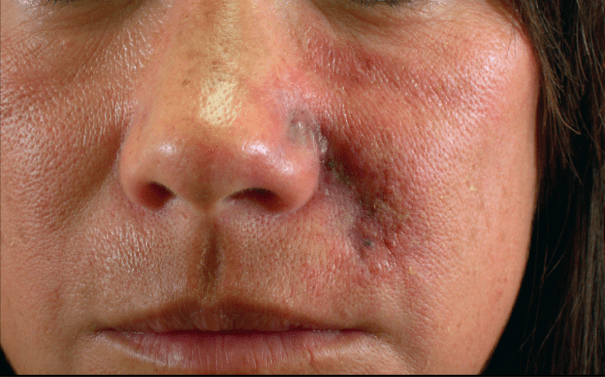
Can fillers cause bruising?
Bruising can occur with any Filler treatment. Bruises should generally be limited to the injection site, and resolve (get better) within a reasonable amount of time. Some people’s bruises go quickly, and some take up to two weeks. They can be covered with makeup but remember not to touch them until 24 hours after treatment so the tiny needle hole is closed and you won’t get an infection.
If you are worried about a bruise that is getting worse, or not resolving, please reach out to us.
Allergies: Can filler make you sick?
It is very unlikely that you would be allergic to any products that are used in aesthetic treatments. Patients can sometimes be sensitive to chemical peels and topically applied products such as our skincare products. It’s important to disclose any allergies to your treating practitioner prior to having any interventions.
Severe allergic reactions are rare, but if you are concerned that you might be allergic it is always advisable to discuss this and find alternatives for treatment. Dermal fillers rarely cause allergies and your practitioner should take a full medical history prior to treatment and discuss possible risks of allergy with you. If they don’t, turn around and walk out, you’re at risk!
Can fillers move: Lumps and bumps after filler treatment
After treatment with dermal fillers, you may experience short-lived lumps and bumps. This is sometimes due to swelling, and sometimes due to a small collection of filler within the tissues.
As long as these lumps and bumps are not painful, they can be managed at your review appointment. Sometimes a light massage by the treating practitioner in order to even out product placement is all it takes. This is why review appointments are so important, especially for dermal fillers. As always if you are experiencing lumps and bumps that haven’t gone away after a few days then speak to a member of our team.
Lip filler infections
Infections are fortunately rare, but when they happen it’s important to treat them appropriately. Dermal fillers are the main culprit for severe infections, especially those from the Hyaluronic acid family of fillers. Filler is literally almost the same as the stuff scientists grow bugs on in the lab. So bacterial really like filler.
If the procedure was contaminated, or the aftercare not quite right, this can introduce infections which can be difficult to treat and can stick around for a very long time.
If you think you have an infection you may experience the following symptoms:
- The area treated feels hot or seems to be radiating heat.
- Increased redness around the treated area
- Swelling in the infected area
- Pain from mild to very severe
- Difficulty moving the affected area (moving your mouth if you’ve had lip filler)
Firstly, speak to your treating practitioner and take (the correct) course of antibiotics. It is important that you go back to your treating practitioner, who should know the guidelines for the type of antibiotic to use.
It’s not a case of any antibiotic will do, as the length of course and the type of antibiotic is important. If you’ve treatment with a beautician this is where their scope of practice ends and they will be very unlikely to be able to help you. If this is the case please get in touch with us or go to a doctor or visit A&E.
If the first line treatment with antibiotics is not effective, samples will have to be taken and cultures raised in order to figure out which bacteria have infected the product and what type of antibiotic to use. This is something that you will need to have done with someone who manages complications frequently. If you feel like you’re stuck or those treating you do not understand the situation, please just get in touch.
Again, if you are the treating practitioner and do not know what to do, don’t panic. Just pick up the phone and we will help you in confidence and with no judging or lecturing. We all want what is best for the patient and there’s no shame in asking for help. We do it all the time!
Can filler damage nerves?
This is very rare, but when filler is placed or injections happen they can result in injury, stretching, severing and and damage to nerves. You may find you feel a patch of numbness that doesn’t go away after the anaesthetic has worn off. You should immediately consult with your practitioner or call us for support.
Other non-clinical concerns
Safety concerns about your practitioner
If you are concerned that your practitioner is not conforming to clean procedures or you are concerned about the standard of hygiene, SPEAK OUT. Unclean rooms, poor cross infection and a cavalier attitude to clinic decontamination results in infection.
If you’re worried that hygiene standards are not being met, DO NOT HAVE TREATMENT. You are putting yourself at risk and you are entitled to say no; just because you’ve made an appointment doesn’t mean you have to go with it. If you are concerned about any elements of your procedure or the setting, you can contact Save Face to see whether your provider is registered and legitimate.
I’m worried about my practitioners qualifications
At Smileworks, we believe that facial aesthetics procedures should only be carried out by people with relevant medical qualifications. Those are dentists, doctors and nurses.
In the UK, beauticians may perform aesthetic procedures as the law surrounding who is allowed to perform toxin and filler treatment is alarmingly insufficient.
Many aesthetic providers have only completed a one or two day course in order to start their businesses. Would you trust someone to perform a medical procedure on you if they have only completed a one-day course to train? And have no medical qualifications? Please, think about your safety, not just what a great deal it is.
MJ has a Masters degree in Aesthetic Medicine. Arguably there are no higher accolades, and we assure you that you will be in the safest of hands. Our other practitioners at Smileworks have completed not only their relevant qualifications but have spent hours training with MJ to ensure that our treatments are predictable and consistent.

I’ve been ripped off!
There are expensive practitioners, and there are cheap ones. Generally, if the offer seems too good to be true, then likely it is. “Filler” that is too cheap is usually that way because corners are being cut somewhere.
This could be practitioners either knowingly or unknowingly using counterfeit products, sharing products on patients or other equally disastrously risky practices. Injecting you and then disappearing is a crime. Have you ever wondered why all the Facebook and Instagram aestheticians only have one name? ‘Aesthetics by Holly’, ‘Aesthetics by Jess’. It’s because when things go wrong they don’t want patients to be able to identify them.
If you are buying simply on the basis of cost we would urge you to save up and go to a registered medical professional rather than the cheapest option as this is often a false economy. Your results are likely to last longer, and be better and safer.
As they say, pay cheap pay twice. If you’ve only been to unregistered practitioners you’d be literally amazed at the beautiful results a decent practitioner can achieve for you.
It costs money to employ the right staff, insure practitioner and premises, have the right protocols and buy the right products. Often you will find that more experienced and more qualified practitioners have higher fees than those with lesser qualifications or experience for these reasons.
At Smileworks we aim to keep prices fair and reasonable in line with the service that we provide; you’ll find that you get a longer lasting, safer and better result for your money.
They breached my confidence!
It’s not just about chatting away to other patients or your friends about you, but simple things like asking permission to use your photos, and making sure you can’t be recognised if posting pictures on the web or social media (unless you have specifically consented).
Responsible practitioners should ask you to sign a photographic release form which allows them to use your clinical photos taken of your treatment. It’s also good manners to still ask if photos can be used, as you may have changed your mind since signing the release form.
Splattering your face all over social media without your consent is not ok, and it’s also illegal.
If it transpires that details of your treatment or any of your personal details have been disclosed without your consent, you should first contact the practitioner to raise this; if this does not fruit you should contact the Information Commissioners Office who take this sort of thing very seriously.
I can’t get hold of anyone for support!
Part of the fee you pay for your treatment should really be spent on putting in place infrastructure to keep you not only safe but happy. Practitioners who are only contactable via text message, WhatsApp or social media are unlikely to be spending money to keep you safe or acquire any sort of decent training. Having reception staff that are contactable in the event of you needing advice is the one of the most basic requirements.
They have disappeared or won’t help me!
Complications happen. That’s the nature of medical treatment – sometimes things don’t go as planned. What separates good from bad practitioners is their response to something going awry.
We hear time and time again that patients have suffered a complication and when they try and get back in touch with their treating practitioner, they want nothing to do with them or cannot be reached.
It’s a worrying trend (and the reason I’m writing to you today) and one that we mainly find with non-healthcare practitioners who don’t have a regulatory body to answer to. As a medical professional, whether it be doctor, nurse or dentist, we have a duty of care to our patients.
As a non-healthcare practitioner, the lines of what is acceptable and what’s not are often blurred. Having a regulator to account to, we find that healthcare practitioners are much less likely to leave their patients high and dry when complications do occur.
It is always really upsetting when patients can’t seem to get help. We’re always here to help and never abandon our patients. If you find you can’t get help from whomever treated you, give us a call on 0151 236 5166.
With any treatment, responsible practitioners book you in for a review to assess the outcome and whether you are happy. If you are not booked for a review, then you do not have a responsible practitioner, it’s that simple.
How to avoid complications
Choosing the right aesthetics practitioner
Choosing someone with medical qualifications and experience is key. Often, these people will be known locally and will have lots of positive reviews and feedback written about them.

You can also search the aesthetic voluntary register, Save Face. They hold a list of qualified practitioners who have been accredited by them, and have evidence of their level of qualification.
Smileworks hold a Care Quality Commission registration and practitioners are also registered with the GDC, NMC or other professional bodies for medical practitioners. This means we have safe premises, good protocols, we treat our patients and staff with dignity and respect and operate within then strictest guidelines. It also means we do thousands of hours of training in our own medical disciplines and in aesthetic medicine. MJ holds a Masters degree in Aesthetic Medicine and is an authority on complication management in aesthetics.
This means that she is not only very experienced in administering facial aesthetics treatments such as fillers and toxins, but she has done a lot of special research into what to do when procedures go wrong.
She is regularly contacted by patients from far and wide, both nationally and internationally, for advice, and she helps professionals who are in need and out of their depth when they have to manage complications on their patients. She’s known for the calm and unflappable way she manages difficult situations and is widely regarded as a good gal to have around in an emergency.
What qualifications to look out for
Anyone with a credit card and an internet connection can buy dermal fillers and start using them on patients. Beauticians are being trained by doctors who have been struck off. That is the state of the industry.
Don’t fall victim to sharks who don’t have your best interests at heart and who will disappear when things go wrong. Granted, you might get a good outcome. But if things go pear-shaped, you’re likely to be hung out to dry – or worse.
- Look for medical professionals – doctors, dentists and aesthetic nurses.
- Ask them how many patients they have seen.
- Ask them how long it took them to train and how long ago that was.
- What extra qualifications in aesthetic medicine do they hold?
What are the red flags?
A clear red flag should be that the practitioner does not hold a medical qualification. Someone who rents a room in a salon and tours different venues like some 1990s boy band – this means you are unlikely to be able to track them down or have a review following treatment.
Someone who is only contactable via social media or text message. If they can’t be bothered to spend some money on staff to manage their patients and diaries, they probably can’t be bothered to manage your complication and probably hardly treat any patients. It’s quite an ask to consent patients, treat them and manage a diary on your own. So where are the corners being cut?
Social media: If they don’t have a proper website, they haven’t invested in their business and the likelihood is they haven’t invested in training or good materials either. Often they have private Facebook profiles, which means patients cannot adequately review them. They will not have a fixed address and this gives you little opportunity for redress when things invariably go wrong.
To see how things are done properly take a look at Lip fillers here.





